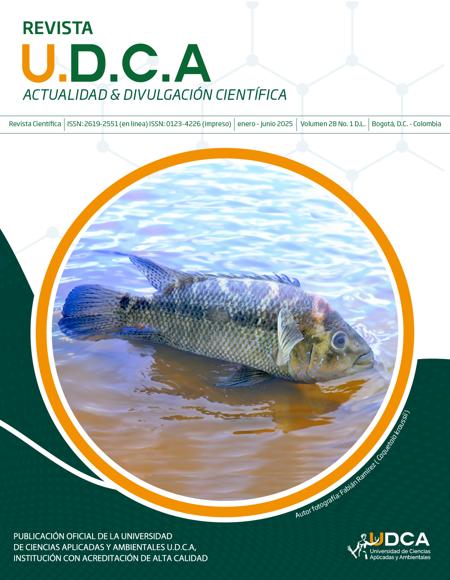Análisis de la producción, características demográficas y socioeconómicas de los productores y campesinos en la zona rural de Medellín
Analysis of production, demographic and socioeconomic characteristics of producers and farmers in the rural area of Medellín
Contenido principal del artículo
Resumen
El estudio analiza la producción agrícola y las condiciones socioeconómicas de los pequeños agricultores en la zona rural de Medellín, Colombia. Identifica problemas, como la falta de prácticas de conservación de suelos, la escasez de financiamiento externo y la incertidumbre sobre la continuidad de cultivos tradicionales, debido a la globalización y el cambio climático. El estudio es relevante al destacar la necesidad de promover la sostenibilidad agrícola y mejorar la resiliencia de los agricultores, mediante prácticas climáticas inteligentes. Se empleó una metodología mixta, combinando encuestas con preguntas abiertas y cerradas, aplicadas a 1.480 agricultores, en cinco corregimientos. Los resultados muestran que la mayoría de los agricultores dependen de su propio capital y carecen de acceso a tecnologías sostenibles. Se proponen estrategias, como la agroforestería, la siembra directa y la recolección de aguas pluviales, para mejorar la producción y la seguridad alimentaria.
Palabras clave:
Descargas
Datos de publicación
Perfil evaluadores/as N/D
Declaraciones de autoría
- Sociedad académica
- Universidad de Ciencias Aplicadas UDCA
- Editorial
- Universidad de Ciencias Aplicadas y Ambientales U.D.C.A
Detalles del artículo
Referencias (VER)
AGUDELO PATIÑO, L. C. 2012. Ruralidad metropolitana. Entre la tradición rural y el «brillo» urbano. Una interpretación. Bulletin de l'Institut français d'études andines (41 (3)), 555-571.
ALTIERI, M. A. 2018. Agroecology: the science of sustainable agriculture. CRC Press.
ANTWI-AGYEI, P.; DOUGILL, A. J.; STRINGER, L. C. 2015. Impacts of land tenure arrangements on the adaptive capacity of marginalized groups: The case of Ghana’s Ejura Sekyedumase and Bongo districts. Land use policy, 49, 203-212. https://doi.org/10.1016/j.landusepol.2015.08.007
CABRERA, M.; RAMÍREZ, W. 2014. Restauración ecológica de los páramos de Colombia. Instituto de Investigación de Recursos Biológicos Alexander von Humboldt.
CHANDRA, A.; MCNAMARA, K. E.; DARGUSCH, P. 2018. Climate-smart agriculture: perspectives and framings. Climate Policy, 18(4), 526-541. https://doi.org/10.1080/14693062.2017.1316968
CHATTERJEE, R.; ISLAM, R.; ACHARYA, S. K.; BISWAS, A. 2022. Conservation Agriculture: Analysis and prioritization of socio-ecological factors operating at farm levels in Ohio, USA. Environmental Science & Policy, 138, 1–10. https://doi.org/10.1016/j.envsci.2022.09.015
DE LA CASA, A. C.; OVANDO, G. G.; DÍAZ, G. J. 2021. ENSO influence on corn and soybean yields as a base of an early warning system for agriculture in Córdoba, Argentina. European Journal of Agronomy, 129, 126340. https://doi.org/10.1016/j.eja.2021.126340
DURANGO ROJAS, N. 2016. Ciudadanías campesinas en el corregimiento de San Cristóbal, municipio de Medellín: el caso de la Asociación Campesina Agroecológica de la Región de Boquerón 2006-2015.
DUTTA, A.; TRIVEDI, A.; NATH, C. P.; GUPTA, D. SEN, HAZRA, K. K. 2022. A comprehensive review on grain legumes as climate‐smart crops: Challenges and prospects. Environmental Challenges, 7, 100479. https://doi.org/10.1016/j.envc.2022.100479
FAO. 2018. Elementos de la agroecología. Guía para la transición hacia sistemas alimentarios y agrícolas sostenibles. FAO; 2018. [acceso 2020 Nov 02]. In.
FISCHER, H. W.; REDDY, N. L. N.; RAO, M. L. S. 2016. Can more drought resistant crops promote more climate secure agriculture? Prospects and challenges of millet cultivation in Ananthapur, Andhra Pradesh. World Development Perspectives, 2, 5–10. https://doi.org/10.1016/j.wdp.2016.06.005
GARCÍA LÓPEZ, V.; GIRALDO, O. F.; MORALES, H.; ROSSET, P. M.; DUARTE, J. M. 2019. Seed sovereignty and agroecological scaling: Two cases of seed recovery, conservation, and defense in Colombia. Agroecology and Sustainable Food Systems, 43(7-8), 827-847. https://doi.org/10.1080/21683565.2019.1578720
GOVAERTS, B.; FUENTES, M.; MEZZALAMA, M.; NICOL, J. M.; DECKERS, J.; ETCHEVERS, J. D.; FIGUEROA-SANDOVAL, B.; SAYRE, K. D. 2007. Infiltration, soil moisture, root rot and nematode populations after 12 years of different tillage, residue and crop rotation managements. Soil and Tillage Research, 94(1), 209–219. https://doi.org/10.1016/j.still.2006.07.013
GRUBER, S.; MÖHRING, J.; CLAUPEIN, W. 2011. On the way towards conservation tillage-soil moisture and mineral nitrogen in a long-term field experiment in Germany. Soil and Tillage Research, 115–116, 80–87. https://doi.org/10.1016/j.still.2011.07.001
GYAMPOH, B.; ASANTE, W. 2011. Mapping and documenting indigenous knowledge in climate change adaptation in Ghana. https://doi.org/10.13140/RG.2.1.4818.6640
HUME, I. V, SUMMERS, D. M.; CAVAGNARO, T. R. 2022. Lawn with a side salad: Rainwater harvesting for self-sufficiency through urban agriculture. Sustainable Cities and Society, 87, 104249. https://doi.org/10.1016/j.scs.2022.104249
IPCC. 2014. Climate change 2014: impacts, adaptation, and vulnerability. Part A: global and sectoral aspects. Contribution of Working Group II to the fifth assessment report of the Intergovernmental Panel on Climate Change. Cambridge University Press, Cambridge, United Kingdom and New York, NY, USA.
KHEIRI, M.; KAMBOUZIA, J.; SAYAHNIA, R.; SOUFIZADEH, S.; MAHDAVI DAMGHANI, A.; AZADI, H. 2023. Environmental and socioeconomic assessment of agroforestry implementation in Iran. Journal for Nature Conservation, 72, 126358. https://doi.org/10.1016/j.jnc.2023.126358
KOLAPO, A.; KOLAPO, A. J. 2023. Implementation of conservation agricultural practices as an effective response to mitigate climate change impact and boost crop productivity in Nigeria. Journal of Agriculture and Food Research, 12, 100557. https://doi.org/10.1016/j.jafr.2023.100557
LIANG, X.; VAN DIJK, M. P. 2011. Economic and financial analysis on rainwater harvesting for agricultural irrigation in the rural areas of Beijing. Resources, Conservation and Recycling, 55(11), 1100–1108. https://doi.org/10.1016/j.resconrec.2011.06.009
MANZUR-TOLEDO, V. M.; BARRERA-BASSOLS, N. 2009. A etnoecologia: uma ciência pós-normal que estuda as sabedorias tradicionais. Desenvolvimento e Meio ambiente, 20. http://dx.doi.org/10.5380/dma.v20i0.14519
MASUPHA, T. E.; MOELETSI, M. E.; TSUBO, M. 2021. Prospects of an agricultural drought early warning system in South Africa. International Journal of Disaster Risk Reduction, 66, 102615. https://doi.org/10.1016/j.ijdrr.2021.102615
MONTOYA-ROJAS, G.; RIVERA-MARROQUÍN, M. 2021. Los componentes ambientales de la cuenca Torca: un insumo para el análisis de los escenarios de variabilidad climática en la ciudad de Bogotá, Colombia. Revista U.D.C.A Actualidad Divulgación Cientifica, 24(1), 1–11. https://doi.org/10.31910/rudca.v24.n1.2021.1833
PARDO-LOCARNO, L. C.; MONTOYA-LERMA, J.; BELLOTTI, A. C.; VAN SCHOONHOVEN, A. 2005. Structure and composition of the white grub complex (Coleoptera: Scarabaeidae*) in agroecological systems of northern Cauca, Colombia. Florida Entomologist, 88(4), 355-363.
PERSSON, J.; JOHANSSON, E. L.; OLSSON, L. 2018. Harnessing local knowledge for scientific knowledge production. Ecology and Society, 23(4). https://doi.org/10.5751/ES-10608-230438
PÖRTNER, H.-O.; SCHOLES, R. J.; AGARD, J.; ARCHER, E.; ARNETH, A.; BAI, X.; BARNES, D.; BURROWS, M.; CHAN, L.; CHEUNG, W. 2021. IPBES-IPCC co-sponsored workshop report on biodiversity and climate change. IPBES and IPCC, 28.
RAMIREZ-SANTOS, A. G.; RAVERA, F.; RIVERA-FERRE, M. G.; CALVET-NOGUÉS, M. 2023. Gendered traditional agroecological knowledge in agri-food systems: a systematic review. Journal of Ethnobiology and Ethnomedicine, 19(1), 1-19. https://doi.org/10.1186/s13002-023-00576-6
RUBA, U. B.; TALUCDER, M. S. A. 2023. Potentiality of homestead agroforestry for achieving sustainable development goals: Bangladesh perspectives. Heliyon, 9(3), e14541. https://doi.org/10.1016/j.heliyon.2023.e14541
SANHUEZA-AROS, J.; PEÑA-CORTÉS, F. 2020. Vista de Uso de la prospectiva estratégica, ordenación territorial y evaluación de impacto como base para la sostenibilidad de los sistemas agrícolas. Revista U.D.C.A Actualidad Divulgación Cientifica, 25(1), 1–12. https://doi.org/10.31910/rudca.v25.nSupl.1.2022.2148.
SHARMA, P.; ABROL, V.; SHARMA, R. K. 2011. Impact of tillage and mulch management on economics, energy requirement and crop performance in maize–wheat rotation in rainfed subhumid inceptisols, India. European Journal of Agronomy, 34(1), 46–51. https://doi.org/10.1016/j.eja.2010.10.003
SOUZA, J. V. R. S.; SAAD, J. C. C.; SÁNCHEZ-ROMÁN, R. M.; RODRÍGUEZ-SINOBAS, L. 2016. No-till and direct seeding agriculture in irrigated bean: Effect of incorporating crop residues on soil water availability and retention, and yield. Agricultural Water Management, 170, 158–166. https://doi.org/10.1016/j.agwat.2016.01.002
WEZEL, A.; HERREN, B. G.; KERR, R. B.; BARRIOS, E.; GONÇALVES, A. L. R.; SINCLAIR, F. 2020. Agroecological principles and elements and their implications for transitioning to sustainable food systems. A review. Agronomy for Sustainable Development, 40, 1-13. https://doi.org/10.1007/s13593-020-00646-z
YADAV, G. S.; BABU, S.; DAS, A.; MOHAPATRA, K. P.; SINGH, R.; AVASTHE, R. K.; ROY, S. 2020. No-till and mulching enhance energy use efficiency and reduce carbon footprint of a direct-seeded upland rice production system. Journal of Cleaner Production, 271, 122700. https://doi.org/10.1016/j.jclepro.2020.122700
YAMANE, T. 1967. Statistics, An Introductory Analysis, 2nd Ed., New York: Harper and Row.
YELELIERE, E.; NYAMEKYE, A. B.; ANTWI-AGYEI, P.; BOAMAH, E. F. 2022. Strengthening climate adaptation in the northern region of Ghana: insights from a stakeholder analysis. Climate Policy, 22(9-10), 1169-1185. https://doi.org/10.1080/14693062.2022.2134085







